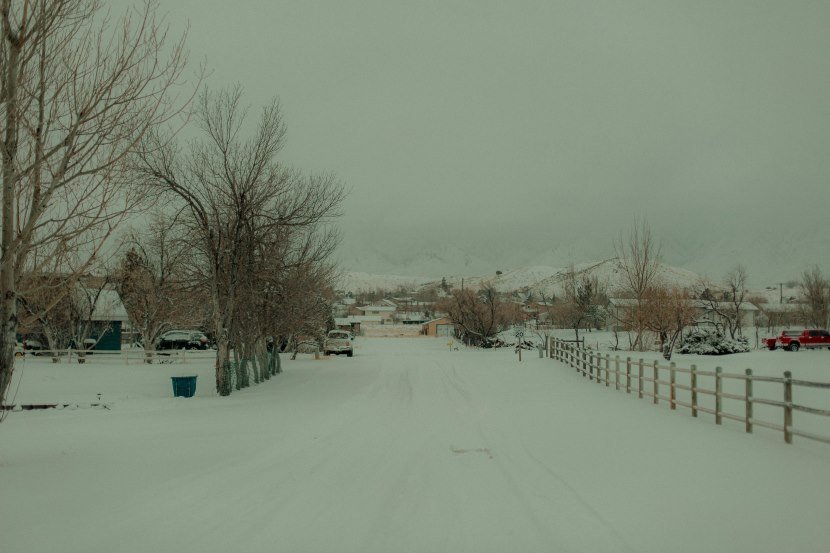Tips & Advices
Snowstorm Disrupts Travel In Eastern Australia: Safety Tips Tourists Need To Know

Monday, August 4, 2025
Over the weekend, several towns in eastern Australia were blanketed by the heaviest snowfall in decades, causing widespread disruptions. Snow, which reached as much as 16 inches (40 cm) in some regions, covered cars, rooftops, and gardens, creating a winter wonderland in places that typically experience milder climates. This rare phenomenon, caused by a cold air front, has had significant effects on both local residents and travellers, with major disruptions to transportation and essential services.
A Storm of Historic Proportions
The snowstorm, which affected parts of northern New South Wales on Saturday, has been described as the most substantial snowfall in the region since the mid-1980s. According to official meteorological reports, snow also reached parts of Queensland, marking the first occurrence in ten years. The intense weather conditions, combined with heavy rain and thunderstorms, resulted in over 1,455 incidents recorded by the New South Wales State Emergency Service.
Authorities have warned that the snowstorm’s aftermath will continue to impact the region for several days, with thousands of homes expected to remain without power for up to 24 hours. Many areas also reported widespread mobile phone outages, complicating communication during an already challenging situation. The combination of snow, rain, and storms has caused major travel disruptions, particularly for those attempting to move through affected regions.
Travel Disruptions and Safety Concerns
The heavy snow and flooding created hazardous conditions, with more than 200 vehicles becoming stranded on the roads. Travellers were advised to avoid unnecessary journeys, especially in the most affected areas. Several roads were impassable due to snow accumulation, and the threat of flooding made matters worse. Additionally, storm damage to buildings and structures compounded the risk, prompting the issuance of major flood warnings in New South Wales.
The transport disruptions were not limited to land routes. In the aftermath of the storm, air travel in parts of eastern Australia also faced severe delays and cancellations. Airports in Sydney, Brisbane, and other major cities experienced disruptions, with limited visibility and adverse weather conditions causing air traffic to be rerouted or delayed. Travellers were strongly encouraged to check flight statuses before heading to the airport and remain prepared for potential delays.
For tourists planning on visiting Australia, particularly in New South Wales and Queensland, understanding the local weather patterns and preparing for sudden storms or snowfalls is crucial. Those hoping to experience the rare snowfall should plan ahead, ensuring they are equipped for cold weather and aware of emergency services available in the region.
A Rare Event With Serious Implications for Tourism
Despite the chaos and disruptions, the heavy snowfall was met with excitement by some locals and tourists alike. Footage from the affected regions showed residents and travellers embracing the unusual weather conditions. Snowmen were built, and snowball fights were had, providing a rare opportunity for Australians to engage with winter activities in a part of the country typically known for its warm climate.
However, the snowstorm also highlighted the volatility of Australia’s weather, particularly in the context of climate change. Meteorologists have pointed out that such extreme weather events have become more frequent in recent years, adding an element of unpredictability to travel plans. Tourists should remain cautious about the potential for sudden shifts in weather, especially when venturing into regions known for their unstable weather patterns.
The tourism industry in Australia, especially in the winter months, may see an uptick in visitors eager to experience these rare conditions. However, travellers must be aware of safety concerns, particularly in terms of road and air travel disruptions. Local authorities have emphasized the importance of monitoring weather forecasts and ensuring that safety measures, such as proper clothing, travel advisories, and emergency contacts, are in place.
Impact on Local Communities and the Search for Missing Persons
As authorities responded to the storm’s aftermath, reports emerged of a car becoming stuck in floodwaters on Saturday evening. Tragically, a female passenger was swept away during the incident, prompting a search operation. Thankfully, the woman was found and rescued safely, but her case underscores the importance of safety precautions when traveling in extreme weather conditions. Local police and emergency teams continued their search for other potential victims, while reinforcing warnings about the dangers of flooding and unstable road conditions.
For tourists and travellers, staying informed about local weather patterns and adhering to safety guidelines is critical during such extreme events. Travel in flooded areas should be avoided, and proper precautions should be taken when venturing into snow-covered regions.
What Travellers Should Know About Visiting Eastern Australia During Winter
For those planning to visit Australia during the winter months, particularly in New South Wales and Queensland, the following tips can help ensure a safe and enjoyable trip:
- Check Weather Forecasts: Before embarking on a trip, travellers should monitor the local weather updates, especially in regions prone to sudden snowstorms and heavy rainfall.
- Stay Updated on Transportation Disruptions: Keep an eye on road conditions, particularly in areas with heavy snowfall, and check for delays or cancellations at airports.
- Prepare for Cold Weather: Even in Australia’s typically warm climates, winter conditions can be severe. Travellers should pack warm clothing, especially in mountainous or elevated regions.
- Follow Safety Instructions: In the event of an emergency, travellers should adhere to evacuation orders and local advisories issued by authorities.
- Follow Local Authorities and Services: In regions affected by snow, rain, and storms, it’s important to follow instructions from the New South Wales State Emergency Service and other local agencies to stay safe.
In conclusion, while Australia’s rare snowstorm event may provide an exciting and unusual experience for some travellers, it also serves as a reminder of the importance of safety and preparedness when traveling during unpredictable weather conditions. Whether seeking adventure in the snow or exploring local attractions, being aware of the local weather and following safety guidelines is essential for a safe and enjoyable journey.
Tips & Advices
Research Reveals Health Insurance Gap for Adopted Kids

COLLEGE PARK, M.d. – People in America adopt hundreds of thousands of children every year, but not all of them receive health insurance once adopted into their second home. A study by University of Maryland (UMD) School of Public Health, out today in Health Affairs , reveals major differences in coverage depending on adoption type (domestic or international) and citizenship status of the adoptive parent.
“Adopted children generally have more and different health needs – such as cognitive or physical difficulties – than non-adopted children. Previous studies, many of which did not differentiate between different types of adoptees, found adopted children were consistently insured,” said study co-author Jamie Fleishman .
“Our study, which considered four types of adoptee, found a very high uninsured rate for some adopted children – particularly those adopted internationally by non-citizens living in the United States.” The study found that almost one-third (30.7%) of the children in this group has no health insurance at all.
Fleishman is a Chinese transnational adoptee who was adopted from China to an American parent. She graduated from UMD in 2024 with a masters in public health (MPH), focusing on health equity, and her master’s thesis was the foundation of this study.
The UMD researchers analyzed insurance coverage over five years (2018 – 2022,) comparing adopted and non-adopted children up to 17 years old who live with their head of household, using data from the American Community Survey (ACS) , which includes over three million adopted and non-adopted children. The study distinguishes between international and domestic adoptions and further distinguishes international adoptees by householder citizenship, because international adoptees of U.S. citizens are, similar to a U.S.-born child, eligible for public insurance coverage such as Children’s Health Insurance Program (CHIP) or Medicaid.
“The findings clearly show that we must not treat adopted children as a single group. International adoptees and domestic adoptees are very different. The citizenship status and other factors such as income of adoptive parents are also different. So policies need to be tailored to these differences,” said Dahai Yue , co-author and assistant professor in SPH’s Department of Health Policy and Management. Yue was Fleishman’s MPH advisor.
The study compared four different groups of adopted children in the U.S. against a control group of non-adopted children: domestic adoptions, international adoptions by U.S. citizens, international adoptions by non-U.S. citizens and children who live with a biological relative, such as a grandparent, but who is not their biological parent.
Children adopted internationally by non-U.S. citizens living in the U.S. have the highest uninsured rate at 30.7%. They also had lower rates of private and public health insurance than other adoptee groups, by 12.1 percentage points and 9.1 percentage points respectively. The non-U.S. citizens adopting these children were also more likely to be the same race as the child, more likely to have an income below the federal poverty line and less likely to own a home than other groups.
The study also highlights a significantly high uninsured rate (7.3%) for children who are living with relatives other than their biological parents, and who are also more likely to live in lower-income families.
“There are likely multiple factors behind these disparities which were not examined in this study. But the data is clear: These groups are not homogenous, despite previous research often treating them as a single population. These children are worthy of policy attention to ensure all children have access to health care in the United States,” said Yue.
Key Findings
Children adopted internationally by non-U.S. citizens living in the U.S.
- Almost one-third (30.7%) of this group has no health insurance at all.
- This group has lower rates of private health insurance (by 12.1 percentage points) and of public health insurance (by 9.1 percentage points) than other adoptee groups.
- The non-U.S. citizens adopting these children were also more likely to be the same race as the child, more likely to have an income below the federal poverty line and less likely to own a home than other groups.
Other adopted and non-adopted children
- Children who are living with relatives other than their biological parents also have a significantly high uninsured rate (7.3%).
- Children who are the most likely to have private insurance coverage are children adopted domestically (56.2%), children adopted internationally to U.S. citizens (89.1%) and nonadopted children (63.8%).
- Children who are most likely to have public insurance coverage, such as Medicaid, are those adopted domestically, and those who live with relatives other than their biological father or mother.
- International adoptees of U.S. citizens were the most insured compared to non-adopted children – in fact, they were more insured than nonadoptees.
Tips & Advices
Women Who Travel Alone Are Sharing The Safety Tips They Swear By

When it comes to traveling, I’ve been to several places around the world over the last few years.
As I continue to travel and explore the world, I am continuously concerned about my safety when traveling solo. That’s why I’ve reached out to the rest of the women on the AllEars team to share the tips we swear by when it comes to traveling safely.
No matter how many times I’ve done it, I still get nervous when it comes to traveling solo. It’s hard not to at times! You hear lots of stories online that can be scary and create anxiety around the thought of going anywhere alone. (Thank you, Liam Neeson and the movie Taken specifically.)
Our entire team travels constantly, those on and off camera! From solo trips to Disney World and Disneyland to heading to Hong Kong and Tokyo, we have been across the globe and have picked up a trick or two along the way. While we want to see and do everything, our top priority when traveling alone as women is safety. (Frankly, everyone should be concerned about being safe!)
Starting off first, be vigilant! Keep your head on a swivel at all times. It doesn’t matter if you’re in a new country or at the mall in your hometown; you always need to be aware of your surroundings. That means no mindless scrolling or listening to music as you walk from destination to destination.
I know, we all love to check TikTok every 5 minutes (and I’m super guilty of that), but the more distracted you are, the easier a target you are. If you have headphones in, you might not be able to hear when someone is walking up to you. Next, we always make sure that someone knows your location. Personally, my husband, mom, dad, brother, sister-in-law, and friends all have my location, so they know where I am no matter what.
I utilize Find My Friends on my iPhone, but I have also used Life 360 in the past just to make sure that trusted people in my life knew I was safe and where I was supposed to be. I also let them know when I’m supposed to arrive at my location and when I’m checking out. If it’s a longer flight, I also make sure to share my flight tracking number with my family as an extra precaution.
It’s also important to share your Uber or Lyft ride details with people when you’re in a car alone. You can have your friends or your family track your specific ride just for peace of mind. These ride-share apps also have safety features that will ask you if you’re okay if your car veers off the path or stops for too long. I’ve been in cars that had to take detours because of unexpected wrecks, and the app will send me a notification asking me to confirm my safety, which I really appreciate.
Uber also recently introduced a new feature that will allow women to select women drivers specifically. According to Uber, the new feature is called Women Preferences. Its features are “designed to give women riders and drivers more choice, more confidence, and more flexibility when they use Uber.” These new features are being tested in Los Angeles, San Francisco, and Detroit for now, but we are really hoping they expand to new areas soon.
When it comes to where we stay, our entire team shared the same sentiment. Make sure you read LOTS of reviews, and if you’re staying at an Airbnb, consider only staying at locations that have a female host or a couple. When reading reviews, make sure that you’re reading reviews from women and their experiences at each location as well. Yes, other people can write helpful reviews, but women tend to understand what safety precautions we’re looking for and can reiterate if a location has what we need.
Another major tip is to not post anything online that would share your exact location. While we do love a good Instagram post, including anything like your exact hotel, hotel room number, any future plans, and more can put you in a dangerous situation. Many people on our team go the extra mile and don’t post at all until they are home from their trips. If you’re being extremely cautious, that is definitely the route to go!
Next, never ever admit that you’re traveling solo! This one is one that’s a tough habit to learn, but we highly encourage you to do so. If people strike up a conversation with you, just say that you’re meeting someone soon or that your friend is in the bathroom. I’ve even gone so far as to fake a phone call when I was uncomfortable in a situation and traveling alone. It might feel strange at first, but there’s safety in numbers (even if those numbers aren’t real.)
I also like to keep pepper spray or other self-defense items when I can, but you can’t always bring them with you. Disney World is a great example of a place where we’ve traveled alone and had to leave our pepper spray keychain at home. That’s when we consider how to use other items like our Owalas if ever necessary. (Those water bottles could definitely be a weapon if needed!)
We also love to utilize fanny packs or other small bags that go in front of our bodies when traveling solo. Sure, they might not seem as cute as a Loungefly at times, but it’s infinitely safer to keep your important items with your name and information close to your chest, where it is much harder to grab. Pickpockets are everywhere, and while they might not initially be after your personal information, they might get it when they grab your wallet or passport.
If you’re driving yourself, always hustle to your car (stay off that phone) when leaving a location, and be sure to check under and behind your seats. Be sure to lock your car as soon as you get in, and if you’re really uncomfortable, don’t be afraid to ask for security to escort you to your car. We’ve done it before, and we will happily do it again if it makes us feel safe. Keep your head high when walking, too, even if you don’t feel confident, just fake it for those walks alone.
Finally, no matter what, our ultimate tip is to trust your gut! The entire team agrees on this point that if you feel unsafe, even if there’s no tangible reason to feel that way, remove yourself from the situation. Trust your intuition and yourself. There have been many times when our gut has told us something was off, and we have decided to trust it. No one knows you like you know yourself, so be confident in what you feel.
At the end of the day, we love solo traveling! It’s offered us so many experiences and helped us grow as people. We love seeing the world and would hate to miss out on it, but we also want to make sure we can continue to travel as safely as possible. As always, be sure to keep following AllEars for more travel tips and tricks.
Tips about Air Travel
What are your best solo travel tips? Tell us in the comments!
Tips & Advices
Are Americans Buying or Skipping Travel Insurance in 2025?
Travel insurance is one of those trip essentials many Americans consider yet far fewer commit to.
In an era of flight disruptions, economic uncertainty, and evolving travel habits, we wanted to understand how travelers are actually approaching trip protection in 2025. Are they playing it safe with coverage, or still rolling the dice?
To find out, we surveyed more than 2,300 travelers across the U.S. to explore how often they buy travel insurance, how much they spend on it, and what kinds of vacation expenses they’re most likely to protect. The results reveal not just how many Americans are buying travel insurance, but also who’s buying it, why they’re doing so, where it’s most common, and how past travel disruptions are influencing attitudes toward trip protection across the country.
Key Takeaways
- 58.6% of U.S. travelers have purchased some form of travel insurance in their lifetimes, while 41.5% say they never have.
- For 2025 trips specifically, 63% of American travelers haven’t purchased any travel insurance.
- Flights are the most commonly insured travel expense nationwide (54.8%), followed by car rentals (44.8%) and hotel bookings (34.5%).
- Maryland leads all states in travel insurance adoption: Nearly half of travelers (49%) have insured their 2025 trips, followed by California (48.2%), Louisiana (48.1%), and Texas (46.6%).
- The majority of Americans (59%) spend less than 5% of their total trip budget on travel insurance.
- The largest share of travelers (43.2%) view going uninsured as only slightly risky.
- While 17.3% of travelers say they’ve lost money by skipping travel insurance, 82.7% report no financial loss. The most common loss is between $101 and $499.
- In Virginia, 28% of travelers say they’ve lost money by skipping travel insurance — the highest rate of any state.
Who’s Buying Travel Insurance and Who’s Still Skipping It?
Despite rising travel costs and increasingly unpredictable trips, many Americans still hesitate to insure their vacations. Our survey found that 58.6% of U.S. travelers have purchased some form of travel insurance in the past, whether directly or through a credit card or membership benefit. Still, 41.5% say they’ve never purchased any kind of travel insurance, highlighting a persistent divide between the cautious and the carefree.
When it comes to 2025 trips specifically, that divide deepens. 63% of travelers say they haven’t secured any type of travel insurance for their past or upcoming 2025 vacations. Just over one-third (36.7%) have some form of protection in place — 25% purchased coverage outright, while 11.7% are passively protected via credit cards or memberships.
There are some noticeable generational differences, as well. Millennials are the least likely to insure their 2025 trips, with 65% traveling without any coverage. Meanwhile, the frequency of flying matters: Travelers who fly 3 to 5 times per year (38.4%) and 6 to 10 times (43%) are more than twice as likely to purchase standalone travel insurance for their 2025 trips compared to those who fly just 1 or 2 times annually (19%).
Income level also correlates closely with insurance adoption. Among Americans earning over $200,000, 34% have insured their 2025 personal trips — nearly double the rate of those earning less than $50,000 (17%).
Where you live plays a role, too. Coastal high-population states and higher-income regions show a stronger commitment to coverage:
States Most Likely To Insure Their Vacations:
- Maryland: 49% insured their 2025 trips
- California: 48.2%
- Louisiana: 48.1%
- Texas: 46.6%
- Delaware: 46%
- New Jersey: 45.3%
- North Carolina: 45.3%
States Least Likely To Insure Their Vacations:
- Colorado: 22.6% insured their 2025 trips
- Montana: 23.3%
- Iowa: 23.4%
- Idaho: 25%
- Michigan: 25.5%
- Indiana: 26%
- Kansas: 26%
In general, Midwestern and Western landlocked states are less likely to insure their trips, perhaps reflecting regional attitudes toward travel risk or fewer perceived barriers to cancellation or delays.
Consistency also remains elusive. While 19.3% of travelers say they always or usually buy travel insurance, a much larger portion (37%) say they never do. Another 32.2% say they purchase insurance about half the time or occasionally. The remainder of travelers rely on credit cards or membership-based coverage.
Even among those who do buy coverage, cost plays a major role. The majority of Americans (59%) spend less than 5% of their total trip budget on travel insurance, while 37.5% spend 5% to 10%, and only 3.6% exceed the 10% mark.
What Travel Purchases Do Americans Protect?
When it comes to trip protection, Americans are most likely to cover the big-ticket items. Flights top the list, with 54.8% of travelers saying they’re most likely to insure their airfare. Car rentals (44.8%) and hotel bookings (34.6%) follow closely behind. Interestingly, hotel coverage is more common than protection for vacation rentals, such as Airbnb, which are insured by 27.3% of travelers. Meanwhile, less expensive or more spontaneous experiences — like concerts (12.3%), tours or excursions (11.4%), and train tickets (7.3%) — are far less likely to be covered.
This pattern suggests a clear logic: Travelers are more inclined to insure bookings with higher upfront costs or stricter cancellation terms, such as flights and rentals, while skipping protection for flexible or lower-stakes purchases.
However, regional habits reveal interesting exceptions. In California, Colorado, Kansas, Oklahoma, and Utah, travelers are more likely to insure car rentals than flights, perhaps a trait attributable to road trip culture or the need to drive in these spread-out regions. Meanwhile, travelers in Connecticut, Delaware, Kansas, Kentucky, Louisiana, New Hampshire, Ohio, and Wisconsin are more likely to insure Airbnbs than hotels. This may be because Airbnbs often involves higher upfront costs and stricter cancellation policies, prompting some travelers to be more cautious about protecting their stay.
Generational trends also shape what people protect. Gen Z stands out as the most likely generation to insure concerts, shows, and event tickets. 18.4% of Gen Zers say they’re likely to insure concerts, compared to 13% of millennials, 9.8% of Gen Xers, and only 7.3% of baby boomers. Gen Z is also more likely than millennials to insure flights, hotels, and Airbnbs, suggesting they’re more cautious about unexpected disruptions and protecting their travel investment.
When asked where they would cut back first to save money, travelers overwhelmingly pointed to flight upgrades — things like business or first class seats — as their first sacrifice. High-end hotels and resorts ranked second on the list of droppable luxuries, followed by fine dining. Notably, more travelers would give up fancy meals on their vacations than forgo travel insurance.
Do Travelers See the Risk or Just Hope for the Best?
Even if plenty of Americans are skipping travel insurance, most aren’t totally in the dark about the risks. When asked how risky it is to travel without insurance in 2025, a combined 91% of travelers acknowledged at least some level of risk. However, the perceived risk tends to be low: The largest share of travelers (43.2%) view going uninsured as only slightly risky. So while most people are aware of potential issues, many don’t see them as urgent or serious enough to prompt action, such as purchasing insurance.
At the state level, there’s a clear overlap between the places where travelers perceive greater risk without travel insurance and those where insurance is more commonly purchased. For example, New Jersey, North Carolina, and Texas all appear in the top states for both perceived risk and actual insurance adoption.
States Where Travelers See the Biggest Risk in Going Uninsured:
- Texas: 31% think skipping insurance is very risky
- Virginia: 29.8%
- North Carolina: 28.3%
- Georgia: 26.8%
- New Jersey: 24.6%
On the flip side, states with the lowest perceived risk also tend to lag in insurance uptake. Hawaii, Iowa, Kentucky, Nevada, and Rhode Island lead the nation in downplaying the risk of traveling uninsured, with as many as 18.8% in Rhode Island believing it’s not risky at all.
States Where Travelers See the Smallest Risk in Going Uninsured:
- Rhode Island: 18.8% think skipping insurance isn’t risky at all
- Kentucky: 17.6%
- Hawaii: 16.7%
- Iowa: 14.9%
- Nevada: 14.9%
Frequent flyers, however, take a far more cautious stance. Those who travel often are more than twice as likely as the average traveler to say that going without insurance in 2025 is extremely risky. This elevated risk awareness may reflect firsthand experiences with delays, cancellations, or emergencies — challenges that infrequent travelers might underestimate.
Who’s Paid the Price for Skipping Travel Insurance?
While many travelers view trip insurance as an optional add-on, those who’ve skipped it and suffered the consequences often feel differently. According to our survey, 17.3% of U.S. travelers say they’ve lost money at some point because they didn’t have travel insurance. That may sound like a small share, but for those affected, the financial sting is real.
The most common loss was between $101 and $499, reported by 45% of those who’ve been burned. Another 28.9% said they lost between $500 and $999, with smaller groups reporting even steeper losses. These setbacks often become teaching moments: 64% of affected travelers say the experience has made them more likely to purchase travel insurance in the future.
Certain states stand out for the financial fallout. In Virginia, 28% of travelers say they’ve lost money by skipping travel insurance — the highest rate of any state. It’s no coincidence that Virginia also ranks as the second-most risk-averse state in our survey when it comes to trip protection, showing how personal financial losses can shift perspectives fast.
Frequent travelers are also more likely to have lost money by going uninsured. The more you fly, the more likely you are to encounter issues like cancellations, lost luggage, and last-minute itinerary changes. That exposure may be why seasoned flyers take insurance more seriously.
Despite these hard lessons, the overwhelming majority — 82.7% — say they’ve never lost money because of a lack of insurance. That may be one reason many still see trip coverage as a “nice-to-have” rather than a travel essential.
Are Attitudes Toward Travel Insurance Changing in 2025?
Travelers in 2025 are beginning to reconsider their stance on trip coverage, but only slightly. When asked whether they’re more likely to purchase travel insurance now compared to 2 years ago, 43.8% said yes, while 42.6% said no. That slim margin shows that while perceptions are starting to shift, many Americans remain unconvinced they need to purchase travel insurance.
The strongest shift is happening among younger travelers. Gen Z leads all age groups, with 49.7% saying they’re more likely to buy travel insurance today than in the past. Millennials, however, are more resistant to change. Only 40.3% say they’re more likely to purchase travel insurance now, while 46.5% say they’re not.
Among those who are now more inclined to buy insurance, the most common reason is simple: peace of mind. Nearly 64.5% of travelers say that avoiding the stress of emergencies is their top motivator. Logistical challenges are also pushing people toward coverage: 41% cite concerns over cancellations or delays, while 37.9% say travel feels more unpredictable overall.
For those who still avoid travel insurance, cost remains the biggest barrier. When asked why they skip it, travelers pointed to the following reasons:
- “It’s too expensive”: 48.6%
- “My trips aren’t expensive enough to justify it”: 37.7%
- “I’ve never had a trip go wrong”: 24.8%
- “I rely on flexible or refundable booking options”: 23.7%
- “I don’t understand what’s covered”: 13.9%
Ultimately, the decision to insure or not often comes down to how much risk a traveler is willing to accept and how much they’re willing to pay to reduce it.
Hot Tip:
Methodology
To understand how Americans view and use travel insurance in 2025, we conducted an online survey of 2,359 U.S. travelers across 45 states between July 9 and July 17, 2025, drawing from a diverse sample across age groups, income levels, and travel frequency. Respondents answered a mix of questions about their travel insurance habits, perceived risk, spending behavior, and past experiences with trip disruptions. We also analyzed differences by state. Because of limited respondent counts, Alaska, Montana, North Dakota, Vermont, and Wyoming were excluded from state-level analyses.
Final Thoughts
While most Americans acknowledge some level of risk when traveling uninsured, the decision to actually buy coverage remains deeply personal and deeply divided. Some travelers have learned the hard way, losing hundreds due to canceled plans or emergencies, while others continue to roll the dice, betting on flexibility or luck.
This study shines a light on how many insure their trips, which expenses they value most, and how travel behavior varies by state, income, and generation. As trip uncertainty grows, so does the need for clear, informed decisions. For travelers looking to protect their next adventure, understanding the best credit cards that offer travel insurance is a smart place to start.
-

 Brand Stories2 weeks ago
Brand Stories2 weeks agoBloom Hotels: A Modern Vision of Hospitality Redefining Travel
-

 Brand Stories1 week ago
Brand Stories1 week agoCheQin.ai sets a new standard for hotel booking with its AI capabilities: empowering travellers to bargain, choose the best, and book with clarity.
-

 Destinations & Things To Do2 weeks ago
Destinations & Things To Do2 weeks agoUntouched Destinations: Stunning Hidden Gems You Must Visit
-

 Destinations & Things To Do1 week ago
Destinations & Things To Do1 week agoThis Hidden Beach in India Glows at Night-But Only in One Secret Season
-

 AI in Travel2 weeks ago
AI in Travel2 weeks agoAI Travel Revolution: Must-Have Guide to the Best Experience
-

 Brand Stories1 month ago
Brand Stories1 month agoVoice AI Startup ElevenLabs Plans to Add Hubs Around the World
-

 Brand Stories3 weeks ago
Brand Stories3 weeks agoHow Elon Musk’s rogue Grok chatbot became a cautionary AI tale
-

 Asia Travel Pulse1 month ago
Asia Travel Pulse1 month agoLooking For Adventure In Asia? Here Are 7 Epic Destinations You Need To Experience At Least Once – Zee News
-

 AI in Travel1 month ago
AI in Travel1 month ago‘Will AI take my job?’ A trip to a Beijing fortune-telling bar to see what lies ahead | China
-

 Brand Stories2 weeks ago
Brand Stories2 weeks agoContactless Hospitality: Why Remote Management Technology Is Key to Seamless Guest Experiences













You must be logged in to post a comment Login